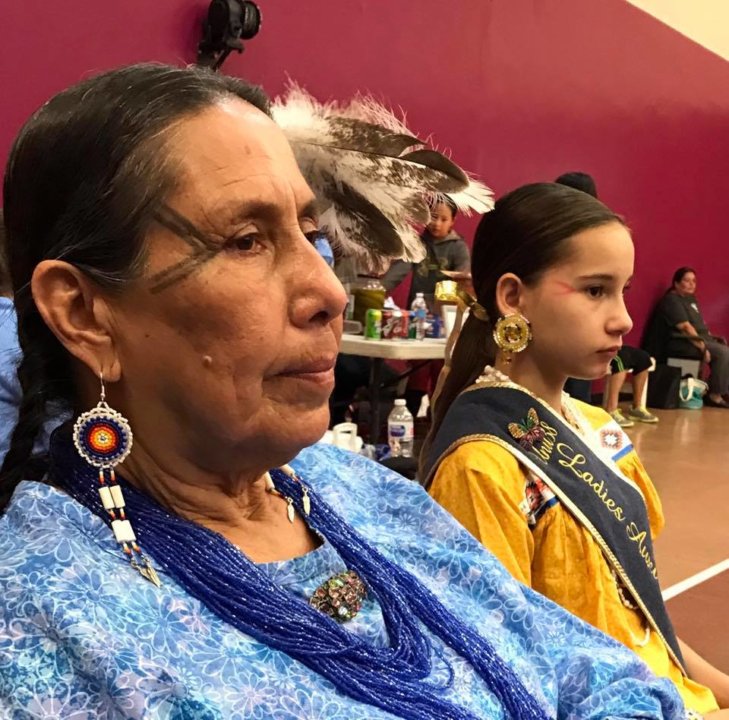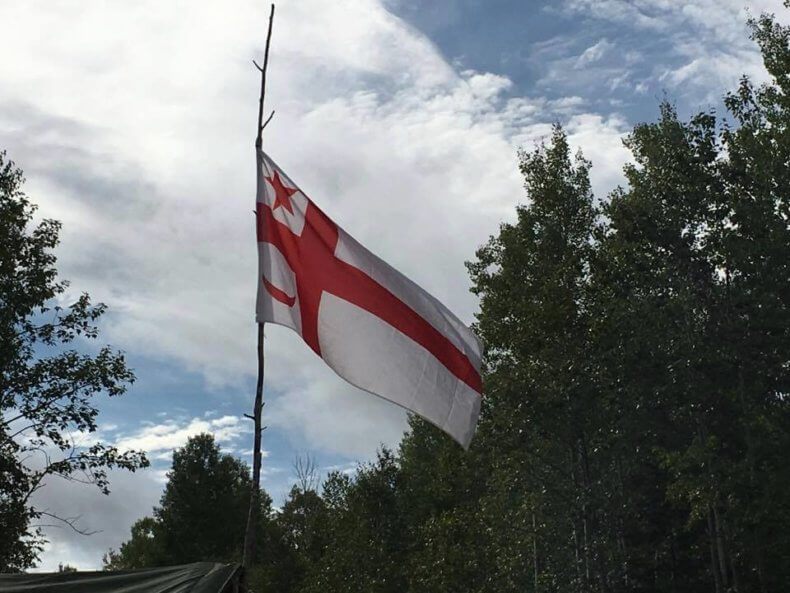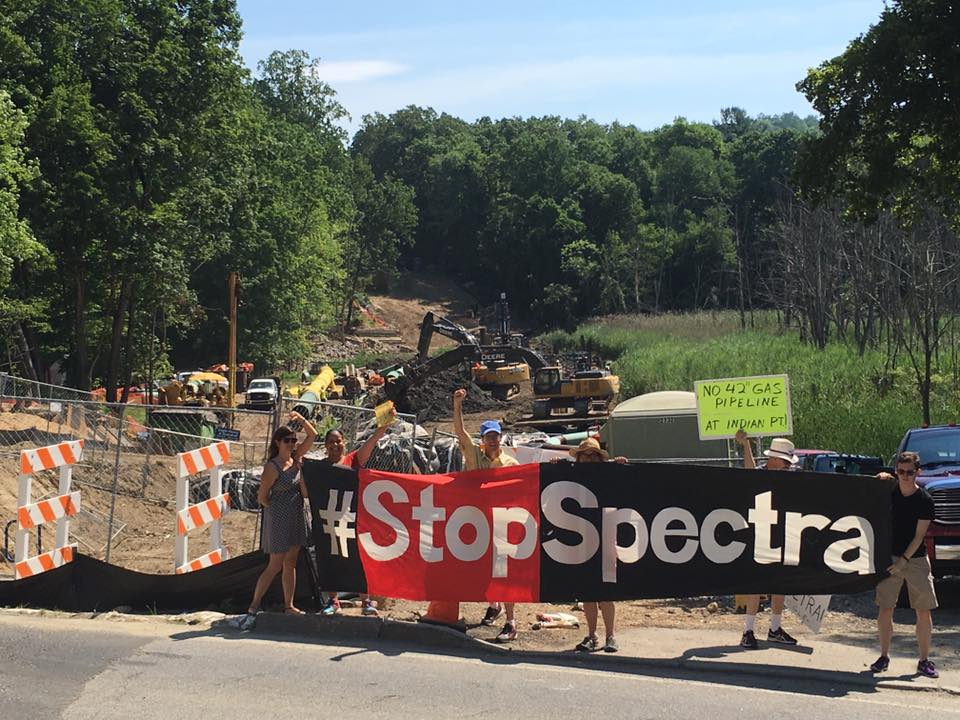
by Deep Green Resistance News Service | Nov 1, 2017 | Indigenous Autonomy
Featured image: Casey Camp-Horinek with her granddaughter
by Movement Rights / via Intercontinental Cry
San Francisco, CA – After suffering for years with poisoned water and serious health issues due to fracking and injection wells on and near their reservation the governing body of the Ponca Nation of Oklahoma voted to pass a statute recognizing the rights of nature on Friday, October 20, 2017. When enacted, the Ponca will be the first tribal nation to recognize the rights of nature into statutory law.
“On Friday, October 20th the Ponca Tribe of Oklahoma took the historic step of agreeing to add a statute to enact the Rights of Nature. We are proud to be moving into the future by honoring our original instructions to respect all life on our Mother Earth,” said Casey Camp-Horinek, a member of the Ponca Tribal Business Council. “We would like to thank everyone who has brought information about the Rights of Nature and those who continue to share ways to bring back respect for the natural laws that have sustained all life for millenniums. A special thanks to Movement Rights founders, Shannon Biggs and Pennie Opal Plant for all the support provided over the last few years.”
Movement Rights has been working with members of the Ponca Nation to assist the tribe with fracking issues utilizing the recognition of the rights of nature as a model to protect the land and health of tribal members. “Dozens of communities in the United States and several countries, including New Zealand, India, Ecuador and Bolivia, have passed laws that stop treating nature as property to be destroyed. The rights of nature legal framework recognizes the legal rights of ecosystems to exist and regenerate their vital life cycles,” said Shannon Biggs, the Executive Director of Movement Rights. “These communities and countries are using this new legal framework to protect people and natural communities from harmful activities including fracking. They are shifting human law to align with natural law.”
Ponca, Oklahoma is the epicenter of earthquakes caused by fracking and injection wells. Tribal members have experienced diseases that have decimated their population since the fracking industry began in their area. Every single water well on the reservation is too toxic to drink, bathe in or allow pets and livestock to drink. There have been 448 earthquakes in and around the Ponca reservation this year, in a state that was essentially earthquake free before the fracking industry moved in to the area. The Ponca Nation is expected to enact the Rights of Nature Statute into law by the end of 2017.
“We all know that water is life. The years of fish kills related to the fracking and injection wells amount to environmental genocide,” said Casey Camp-Horinek. “It is going to take all of us humans because we’re speaking for those without voices, for the deer, the cattle, those that fly. In our tribe we have a funeral a week now. We’re being fracked to death and It’s time to take a stand for our people and defend the earth.”
The Ponca Nation and Movement Rights also conducted two events which took place on Saturday, October 22nd called “Ponca Environmental Community Action Day”. The day included a prayer walk to the Phillips 66 refinery in the City of Ponca as well as a community meeting. “I feel like we are gaining strength, we had more tribal nations represented this time as well as non-natives,” said Ponca Tribal member, Suzaatah Williams. “We had elders and even a newborn on this walk and every age group in between. Even if only one of these people share the information they learned we have made a difference. Knowledge is power and we are only getting stronger!”
Speakers for the community events included Casey Camp-Horinek, Mekasi Horinek, Shannon Biggs, Bryan Parras of the Sierra Club and TEJAS in Houston, Texas, and Robby Diesu, coordinator for the National Stop the Frack Attack Network based in Washington, DC.
“Most importantly, thanks to our Creator, Wakonda,” said Casey Camp-Horinek. “We believe that the prayers and guidance provided are leading us to further protect our Mother Earth, who sustains us; and make a way for the generations to come.”
Contact:
Casey Camp-Horinek caseycamphorinek@yahoo.com (580) 716-7015
Shannon Biggs shannon@movementrights.com (415) 298-9419
Pennie Opal Plant pennie@gatheringtribes.com (510) 390-0386

by Deep Green Resistance News Service | Aug 25, 2017 | Indigenous Autonomy
by Traditional Mi’kmag 1st & 7th District Chiefs / Intercontinental Cry
Today, we traditional council chiefs from the 1st and the 7th Districts of Mi’kma’ki have gathered at the Junexit Banquet organized by the Camp by the River. We are here not only to support the occupation that has been set up on August 7th against Junex but also to assert our inherent rights and title over our unceded and unsurrendered territory, as affirmed by the 1763 Royal Proclamation. We assert our presence here to protect our territory under the Protection clauses for unceded lands, as protected by Constitutional Rights, Charter Rights, Human Rights, and International Rights.
The Chief of Mi’kam’ki 1st District, Unamaki, which is currently involved in its own struggle against oil and gas exploration by Alton Gas, as well as the 2011 historic and victorious struggle against fracking in Elsipogtog (6th District), thus adds her support to the 7th District’s current opposition to exploration and extraction on its land by Junex.
After the dismantling of the blockade, the struggle is just beginning, and coalitions are being formed between Mi’kmaq District Chiefs from the northern and southern ends of our Nation, as well as with land and water protectors from other nations.
As Traditional Mik’maq council Chiefs, we affirm our complete and inviolable sovereignty over the land Junex is illegally attempting to destroy. We are not concerned by the Indian Act (INAC) leadership, who’s authority lies exclusively within the border of the Federal Indian Reserves as stated in the Chapter 91.24 of the Constitution of Canada (Indians and land reserved for Indians). INAC describes only boundaries of reservations, and not traditional hunting and fishing territories. Outside of Federal Indian Reserves, the authority and jurisdiction lies with the rights holders, i.e. traditional district chiefs.
We demand an immediate moratorium on all exploration and/or development of oil and/or gas on traditional mik’ma’ki territory, District 7.
As Mi’kmaq peoples, we have a duty and obligation to defend and protect our Ancestral District territory. We cannot remain silent and condone any oil drilling within our territory that will poison our lands, waters, fauna and wildlife. We call all groups and individuals concerned by the protection of water and land on Gespegawagi territory to voice their support, take action, and join the struggle on site.
Suzanne Patles, 1st Unamaki district
Gary Metallic Sr, 7th District Gespegawagi

by Deep Green Resistance News Service | Apr 25, 2017 | Lobbying, NEWS
Featured image: Fracking well. The damage that causes earthquakes seems to occur after the drilling, when the wastewater is injected deep underground, stimulating existing fault lines. Indigenous and other communities want Colombia to join France, Germany, Scotland and Bulgaria in banning fracking. By Thinkstock.
by Rick Kearns / Indian Country Today Media Network
Fracking is coming to indigenous Colombian territories and other parts of the country, and activists are trying to halt the process.
The controversial process known as fracking, short for hydraulic fracturing, involves injecting water, sand and various chemicals at high pressure into subterranean rocks, so as to force open existing fissures and extract oil or gas.
Environmentalists, scientists and others around the world have asserted that fracking can contaminate surface water and subterranean aquifers and has been linked to earthquakes and low birth rates among other things. At least four countries – France, Germany, Scotland and Bulgaria – have banned fracking and other countries and regions are considering similar measures.
On March 22, close to 40 environmental organizations, trade unionists and land defenders known as the Alliance for a Colombia Free of Fracking sent a public letter to Colombian President Juan Manuel Santos, asking him to issue a moratorium on fracking due to it’s potential harm to the environment and to thousands of Indigenous and other Colombians living near the wells.
According to an April report, the Colombian government had granted 43 gas and oil concessions to various corporations including multinationals such as ExxonMobil. ConocoPhillips and Drummond Ltd.
The activists note in the letter that fracking has been associated with increased seismic activity. They point to a study showing how wastewater fracking wells in Oklahoma cause a dramatic increase: from 50 seismic events at a level of 3 in 2010 to 400 level 3 earthquakes in 2014, an 800 percent jump.
“And in terms of public health,” the Alliance letter continued, “there are studies from the U.S., Canada and the European Union that connect the proximity of people to the areas where fracking activities are carried out with cases of neural tube alterations (The neural tube is the structure in the embryo that ultimately forms the brain and spinal cord), births with low birth weight, other birth defects and an increase in the incidence of congential heart problems.”
The activists asserted that “there is evidence that emissions from wastewater fracking wells can travel through the air to residential zones where they can cause asthma…”
Some of the fracking areas overlap with Yupka, Wiwa and Wayuu territories and activists have noted that these projects would violate the land rights of these Indigenous Peoples and potentially others.
While none of these communities have issued press statements regarding fracking, two of the largest Indigenous organizations have identified the process as a serious problem in past reports.
In September of last year, the National Indigenous Organization of Colombia (ONIC) published a statement by the allied Association of Indigenous Councils of Northern Cauca (ACIN) about the peace process between the government and the FARC guerillas. In that statement they pointed out that the Indigenous communities were worried about the government’s policies involving “extractavism” and “fracking” and the lack of prior consultation of the communities which is against Colombian and international laws.
In response to the recent developments the Alliance group known as the Corporation for the Defense of Water, Territory and Ecosystems (CORDATEC) held a two day conference on April 19 and 20 on “The Social-Environmental Impact of Fracking” in an area already affected by gas exploration.
Among the panel topics at the conference were “Environmental Impact” and “Resistance and Social Conflicts.”
As of press time President Santos had not publicly responded to the letter from the Alliance.
Photo by Brad Weaver on Unsplash

by Deep Green Resistance News Service | Aug 30, 2016 | Obstruction & Occupation
By ResistAIM
Brooklyn, NY – Concerned New Yorkers blocked the doors of National Grid’s downtown Brooklyn office at noon on Monday, August 29 to protest their support of Spectra Energy’s AIM Pipeline, a -brooklyn-demanding-national-grid-stop-support-spectra-energys-dangerous-aim-pipelinehigh-pressure methane gas pipeline that will bring fracked gas from Pennsylvania to New England. Members of 350Brooklyn.org, 350NYC.org, and ResistAIM came together to demand that National Grid end their contract agreement with Spectra Energy. The pipeline’s route runs 105 feet from infrastructure critical to the Indian Point Nuclear Power Plant in New York’s Westchester County. “National Grid is risking the safety of the 17 million people who live within 50 miles of the aging Indian Point reactor so it can sell gas in other parts of the country and the world,” says Mimi Bluestone of 350Brooklyn, one of eight people arrested as part of the day’s action. “Our governor and our US senators have called on the federal government to withdraw its authorization for this pipeline. But without National Grid’s end-of-pipeline agreement to buy this gas, the project could not be economically viable.”
Both elected officials and local residents have repeatedly raised concerns about the pipeline’s safety. This past February, Governor Andrew Cuomo asked the pipeline’s builder, Spectra Energy Corp of Texas, to suspend the project pending an independent safety analysis. “The safety of New Yorkers is the first responsibility of state government,” Cuomo said in making the request. In May, New York Senators Chuck Schumer and Kirsten Gillibrand asked the Federal Energy Regulatory Commission, which has jurisdiction over the pipeline, to halt construction pending such a study. Spectra Energy and FERC have denied the governor’s and the senators’ requests.
The AIM (Algonquin Incremental Market) pipeline is designed solely to deliver natural gas to New England; New York is simply a “pass through” state. The pipeline will enter New York in Rockland County, pass under the Hudson River, and then cross Westchester County en route to Connecticut. Built in the 1970s, Indian Point Nuclear Power complex remains active and contains decades of spent radioactive nuclear fuel, while over 17 million people live within 50 miles of Indian Point. National Grid, a British multinational, expanded into the United States beginning in 2000 by buying a number of local utilities in New England and New York, including the successor to Brooklyn Union Gas. It is a major potential customer for the natural gas that the AIM pipeline would transport to New England and so has the power to determine the financial viability of this project. Last week, National Grid withdrew its petition for a 20-year contract on Spectra’s Access Northeast project; however, National Grid is still expected to purchase gas flowing through the AIM Pipeline and so activists in Rhode Island, Massachusetts and New York are continuing to call on National Grid to cancel the contract.
The AIM pipeline is scheduled to be completed in November 2016, which calls for immediate action. On Monday evening, following the arrests at National Grid, concerned New Yorkers are gathering at the Brooklyn home of Senator Charles Schumer to encourage him to stand with New Yorkers by making a public appearance to denounce the pipeline and calling for a Government Accountability Office (GAO) investigation of the Federal Energy Regulatory Commission – more details can be found HERE.
350.org is a national organization working to keep carbon in the ground and to build a new, more equitable low-carbon economy. Its affiliates like 350NYC and 350Brooklyn work on local issues related to climate change. ResistAIM is a coalition of environmental advocates, Westchester residents and concerned New Yorkers that have been taking nonviolent direct action to stop the AIM Pipeline since November 2015.
A map of the AIM pipeline’s route: http://www.spectraenergy.com/Operations/US-Natural-Gas-Operations/New-Projects-US/Algonquin-Incremental-Market-AIM-Project/
A map of the pipeline’s proximity to the Indian Point Nuclear Power Plant: https://sape2016.org/2015/07/16/nuclear-regulatory-commission-withheld-and-misrepresented-critical-information-used-to-evaluate-and-approve-the-siting-of-the-spectra-aim-pipeline-alongside-indian-point/
For Cuomo’s position: http://www.bloomberg.com/news/articles/2016-02-29/cuomo-seeks-halt-of-spectra-algonquin-gas-line-for-safety-review
For Senator Gillibrand and Schumer’s position: https://www.gillibrand.senate.gov/newsroom/press/release/schumer-gillibrand-urge-ferc-to-suspend-construction-on-aim-pipeline-expansion-until-independent-health-and-safety-studies-are-conducted
For 350NYC: https://350nyc.org/
For 350Brooklyn: http://350brooklyn.org/
For ResistAIM: www.resistaim.com

by Deep Green Resistance News Service | Jul 20, 2016 | Repression at Home
Featured image: Break Free protesters at a fracking site in Colorado on May 14. (Photo: Christian O’Rourke/Survival Media Agency)
By Steve Horn and Lee Fang / The Intercept
When more than 300 protesters assembled in May at the Holiday Inn in Lakewood, Colorado — the venue chosen by the Bureau of Land Management (BLM) for an auction of oil and gas leases on public lands — several of the demonstrators were in fact undercover agents sent by law enforcement to keep tabs on the demonstration, according to emails obtained by The Intercept.
The “Keep it in the Ground” movement, a broad effort to block the development of drilling projects, has rapidly gained traction over the last year, raising pressure on the Obama administration to curtail hydraulic fracturing, known as fracking, and coal mining on federal public lands. In response, government agencies and industry groups have sharply criticized the activists in public, while quietly moving to track their activities.
The emails, which were obtained through an open records act request, show that the Lakewood Police Department collected details about the protest from undercover officers as the event was being planned. During the auction, both local law enforcement and federal agents went undercover among the protesters.
The emails further show that police monitored Keep it in the Ground participating groups such as 350.org, Break Free Movement, Rainforest Action Network, and WildEarth Guardians, while relying upon intelligence gathered by Anadarko, one of the largest oil and gas producers in the region.
“Gentlemen, Here is some additional intelligence on the group you may be dealing with today,” wrote Kevin Paletta, Lakewood’s then-chief of police, on May 12, the day of the protest. The Anadarko report, forwarded to Paletta by Joni Inman, a public relations consultant, warned of activist trainings conducted by “the very active off-shoot of 350.org” that had “the goal of encouraging ‘direct action’ such as blocking, vandalism, and trespass.”
The protesters waved signs and marched outside of the Holiday Inn. The auction went on as planned and there were no arrests.
“I believe the BLM reached out to us,” Steve Davis, the public information officer for the Lakewood police, told The Intercept about preparations for the protest. He added that the protest was “very peaceful.”
“Our goal is to provide for public safety and the safety of our employees,” says Steven Hall, the BLM Colorado Communications Director, when asked about the agency’s undercover work. “Any actions that we take are designed to achieved those goals. We do not discuss the details of our law enforcement activities.”
BLM reimbursed the Lakewood police for costs associated with covering the protest, the emails and a scanned copy of the check show.

Police officers block the entrance to the Bureau of Land Management auction at the Holiday Inn of Lakewood, Colorado, May 12, 2016. Photo: Olivia Abtahi/Survival Media Agency
Aggressive Stance
Despite a relatively uncontroversial protest, the tactics revealed by the emails, recent public statements, and other maneuvers suggest that the federal government is beginning to take a more aggressive stance toward the Keep it in the Ground movement.
“I’m really wondering what more the BLM is up to,” said Jeremy Nichols, a climate and energy program director for WildEarth Guardians. “Some of the emails indicate more extensive intel gathering on their end.”
“Why are climate activists, who are only calling on the BLM to follow President Obama’s lead and heed universally accepted science, facing this kind of uphill response?” Nichols asked rhetorically. “It’s a shame that the BLM has turned climate concerns into a law enforcement issue instead of a genuine policy discussion.”
During a congressional hearing in March, Neil Kornze — the agency’s Director and former senior policy advisor for U.S. Senate Minority Leader Harry Reid — appeared to compare the anti-fracking activists to the armed anti-government militia members who occupied the Malheur National Wildlife Refuge in Oregon.
“We have had a situation where we have had militia; we’ve had people raising arms at different times. We are on heightened alert and we are concerned about safety. And so a situation that we are not used to, separating out who is a bidder and who is not, gives us pause,” Kornze said, explaining to GOP congressman that his agency faced “abnormal security” concerns.
The bureau maintains its own force of special agents to investigate crimes committed on public lands. The website for the agency notes that “investigations may require the use of undercover officers, informants, surveillance and travel to various locations throughout the United States.”
Broader Trend
In recent years federal and private sector groups have poured resources into surveilling environmental organizations.
In 2013, The Guardian revealed that the FBI had spied on activists organizing opposition to the Keystone XL pipeline. The agency “collated inside knowledge about forthcoming protests, documented the identities of individuals photographing oil-related infrastructure, scrutinized police intelligence and cultivated at least one informant.” The FBI later confirmed that the investigation violated its own guidelines.
In 2011, an executive with Anadarko boasted that his company was deploying military-like psychological warfare techniques to deal with the “controversy that we as an industry are dealing with,” calling the opposition to the industry “an insurgency.”

Protestors gather inside the Holiday Inn of Lakewood, Colorado to protest the auctioning of public lands for oil and gas companies, May 12, 2016. Photo: Olivia Abtahi/Survival Media Agency
Online Auctions to “End the Circus”
The focus on preventing the leasing of public lands for fracking gained national headlines in 2008 when activist Tim DeChristopher successfully bid on 22,000 acres of oil and gas land in Utah. DeChristopher, who served two years in prison, did not intend to pay but won the bid in order to disrupt the auction and call attention to the leasing program. That pricing regime allows private corporations to pay deeply discounted rates — as little as $1.50 per acre — for drilling rights.
In 2009, the U.S. Department of Interior’s Office of Inspector General released a report calling on the bureau to do a study on “which auction process is best suited for oil and gas leases” in order to prevent the next Tim DeChristopher, whose action landed an explicit mention in the report’s introduction. An email exchange from the day before the Lakewood Holiday Inn action shows both a Lakewood police officer and BLM officer on high alert about the possibility of another DeChristopher-type action taking place. Among the choices laid out in the report as a possible new bidding method was online bidding.
Just days after the Lakewood protest, Kathleen Sgamma — a lobbyist for industry-funded group Western Energy Alliance — advocated for online bidding as a means to “end the circus.” In a May 18 email, BLM Office of Law Enforcement Special Agent-in-Charge Gary Mannino thanked Lakewood Police Chief Kevin Paletta for his department’s help and conveyed that public auctions could soon become a thing of the past.
Congress has followed suit. On June 24, Rep. Alan Lowenthal, D-Calif., and Rep. Garret Graves, R-La., introduced Innovation in Offshore Leasing Act (H.R. 5577), which calls for online bidding for oil and gas contained in waters controlled by the federal government. On July 6, the U.S. House Subcommittee on Energy and Mineral Resources held a hearing on the bill and it has since passed out of the House Natural Resources Committee.
While the oil and gas industry has come out in support of online bidding, and one contractor in particular named EnergyNet stands to profit from such an arrangement, several environmental groups issued a statement decrying the shift toward online bidding. EnergyNet, whose CEO testified at the June 24 congressional hearing, will oversee a September 20 BLM auction originally scheduled to unfold in Washington, D.C.
Two recently-released studies concluded that phasing out fossil fuel leases on public lands is crucial for meeting the 2° C climate change temperature-rise goal, with one concluding that even burning the existing fossil fuels already leased on public lands would surpass the 2° C goal. After the release of those two studies, environmental groups filed a legal petition with the Interior Department calling for a moratorium on federal fossil fuels leases.







